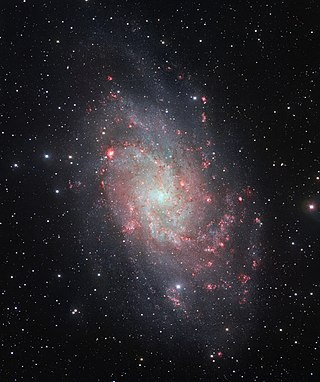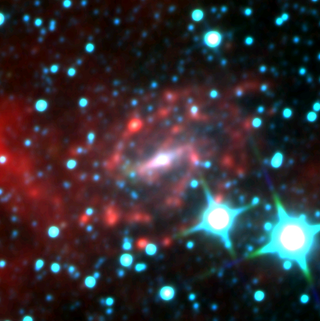Related Research Articles

A galaxy is a system of stars, stellar remnants, interstellar gas, dust, dark matter, bound together by gravity. The word is derived from the Greek galaxias (γαλαξίας), literally 'milky', a reference to the Milky Way galaxy that contains the Solar System. Galaxies, averaging an estimated 100 million stars, range in size from dwarfs with less than a hundred million stars, to the largest galaxies known – supergiants with one hundred trillion stars, each orbiting its galaxy's center of mass. Most of the mass in a typical galaxy is in the form of dark matter, with only a few percent of that mass visible in the form of stars and nebulae. Supermassive black holes are a common feature at the centres of galaxies.

The Andromeda Galaxy, also known as Messier 31, M31, or NGC 224 and originally the Andromeda Nebula, is a barred spiral galaxy with the diameter of about 46.56 kiloparsecs approximately 765 kpc from Earth and the nearest large galaxy to the Milky Way. The galaxy's name stems from the area of Earth's sky in which it appears, the constellation of Andromeda, which itself is named after the princess who was the wife of Perseus in Greek mythology.

The Triangulum Galaxy is a spiral galaxy 2.73 million light-years (ly) from Earth in the constellation Triangulum. It is catalogued as Messier 33 or NGC (New General Catalogue) 598. With the D25 isophotal diameter of 18.74 kiloparsecs (61,100 light-years), the Triangulum Galaxy is the third-largest member of the Local Group of galaxies, behind the Andromeda Galaxy and the Milky Way.

The Chandra X-ray Observatory (CXO), previously known as the Advanced X-ray Astrophysics Facility (AXAF), is a Flagship-class space telescope launched aboard the Space ShuttleColumbia during STS-93 by NASA on July 23, 1999. Chandra is sensitive to X-ray sources 100 times fainter than any previous X-ray telescope, enabled by the high angular resolution of its mirrors. Since the Earth's atmosphere absorbs the vast majority of X-rays, they are not detectable from Earth-based telescopes; therefore space-based telescopes are required to make these observations. Chandra is an Earth satellite in a 64-hour orbit, and its mission is ongoing as of 2023.

The Galactic Center or Galactic Centre is the rotational center, the barycenter, of the Milky Way galaxy. Its central massive object is a supermassive black hole of about 4 million solar masses, which is called Sagittarius A*, a compact radio source which is almost exactly at the galactic rotational center. The Galactic Center is approximately 8 kiloparsecs (26,000 ly) away from Earth in the direction of the constellations Sagittarius, Ophiuchus, and Scorpius, where the Milky Way appears brightest, visually close to the Butterfly Cluster (M6) or the star Shaula, south to the Pipe Nebula.

Dwingeloo 1 is a barred spiral galaxy about 10 million light-years away from the Earth, in the constellation Cassiopeia. It lies in the Zone of Avoidance and is heavily obscured by the Milky Way. The size and mass of Dwingeloo 1 are comparable to those of Triangulum Galaxy.

The Whirlpool Galaxy, also known as Messier 51a (M51a) or NGC 5194, is an interacting grand-design spiral galaxy with a Seyfert 2 active galactic nucleus. It lies in the constellation Canes Venatici, and was the first galaxy to be classified as a spiral galaxy. It is about 31 million light-years (9.5 Mpc) away from Earth and 76,900 ly (23,580 pc) in diameter.

The Sombrero Galaxy is a peculiar galaxy of unclear classification in the constellation borders of Virgo and Corvus, being about 9.55 megaparsecs from the Milky Way galaxy. It is a member of the Virgo II Groups, a series of galaxies and galaxy clusters strung out from the southern edge of the Virgo Supercluster. It has a diameter of approximately 15 kiloparsecs, three-tenths the size of the Milky Way.

NGC 891 is an edge-on unbarred spiral galaxy about 30 million light-years away in the constellation Andromeda. It was discovered by William Herschel on October 6, 1784. The galaxy is a member of the NGC 1023 group of galaxies in the Local Supercluster. It has an H II nucleus.

The Center for Astrophysics | Harvard & Smithsonian (CfA), alternatively called the Harvard–Smithsonian Center for Astrophysics, is an astrophysics research institute jointly operated by the Harvard College Observatory and Smithsonian Astrophysical Observatory. Founded in 1973 and headquartered in Cambridge, Massachusetts, the CfA leads a broad program of research in astronomy, astrophysics, Earth and space sciences, as well as science education. The CfA either leads or participates in the development and operations of more than fifteen ground- and space-based astronomical research observatories across the electromagnetic spectrum, including the forthcoming Giant Magellan Telescope (GMT) and the Chandra X-ray Observatory, one of NASA's Great Observatories.

The 1.2 meter Millimeter-Wave Telescope at the Center for Astrophysics | Harvard & Smithsonian and its twin instrument at CTIO in Chile have been studying the distribution and properties of molecular clouds in our galaxy and its nearest neighbours since the 1970s. The telescope is nicknamed "The Mini" because of its unusually small size. At the time it was built, it was the smallest radio telescope in the world. Together, "The Mini" and its twin in Chile have obtained what is by far the most extensive, uniform, and widely used galactic survey of interstellar carbon monoxide. "The Mini" is currently in operation from October to May each year.

The Milky Way is the galaxy that includes the Solar System, with the name describing the galaxy's appearance from Earth: a hazy band of light seen in the night sky formed from stars that cannot be individually distinguished by the naked eye. The term Milky Way is a translation of the Latin via lactea, from the Greek γαλακτικὸς κύκλος, meaning "milky circle". From Earth, the Milky Way appears as a band because its disk-shaped structure is viewed from within. Galileo Galilei first resolved the band of light into individual stars with his telescope in 1610. Until the early 1920s, most astronomers thought that the Milky Way contained all the stars in the Universe. Following the 1920 Great Debate between the astronomers Harlow Shapley and Heber Doust Curtis, observations by Edwin Hubble showed that the Milky Way is just one of many galaxies.

NGC 772 is an unbarred spiral galaxy approximately 130 million light-years away in the constellation Aries.

Abraham "Avi" Loeb is an Israeli-American theoretical physicist who works on astrophysics and cosmology. Loeb is the Frank B. Baird Jr. Professor of Science at Harvard University. He had been the longest serving chair of Harvard's Department of Astronomy (2011–2020), founding director of Harvard's Black Hole Initiative and director of the Institute for Theory and Computation within the Harvard-Smithsonian Center for Astrophysics.

Sagittarius A is a complex radio source at the center of the Milky Way, which contains a supermassive black hole. It is located in the constellation Sagittarius, and is hidden from view at optical wavelengths by large clouds of cosmic dust in the spiral arms of the Milky Way. The dust lane that obscures the Galactic Center from a vantage point around the Sun causes the Great Rift through the bright bulge of the galaxy.

The Far 3 kpc Arm was discovered in 2008 by astronomer Tom Dame, while preparing a talk on the galaxy's spiral arms for a meeting of the 212th American Astronomical Society. It is one of Milky Way's spiral arms and it is located in the first galactic quadrant at a distance of 3 kiloparsecs from the Galactic Center. Along with the Near 3 kpc Arm, the existence of which has been known since the mid-1950s, the counterpart inner arms establish our Galaxy's simple symmetry.

The Near 3 kpc Arm was discovered in the 1950s by astronomer van Woerden and collaborators through 21-centimeter radio measurements of HI. It was found to be expanding away from the center of the Milky Way at more than 50 km/s. This spiral arm contains about 10 million solar masses of gas, mostly hydrogen atoms and molecules. It is named for its distance from the Galactic Center. It is about 5.2 kpc from the Sun, and is located in the fourth galactic quadrant.
Patrick Thaddeus was an American professor and the Robert Wheeler Willson Professor of Applied Astronomy Emeritus at Harvard University. He is best known for mapping carbon monoxide in the Milky Way galaxy and was responsible for the construction of the CfA 1.2 m Millimeter-Wave Telescope.
Nia Imara is an American astrophysicist, artist, and activist. Imara's scientific work deals with galactic mass, star formation, and exoplanet detection. Imara was the first African-American woman to earn a PhD in astrophysics at the University of California, Berkeley and was the inaugural postdoctoral fellow in the Future Faculty Leaders program at Harvard University. In 2020, Imara joined the University of California, Santa Cruz as an Assistant Professor in the Department of Astronomy.

Frank Eisenhauer is a German astronomer and astrophysicist. He is best known for his contributions to interferometry and spectroscopy and the study of the black hole at the centre of the Milky Way.
References
- 1 2 3 "Bio" (PDF). www.cfa.harvard.edu.
- ↑ Sky and Telescope magazine, July 1988, p.24
- 1 2 "History of the Mini's". cfa.harvard.edu. Retrieved 2014-02-11.
- ↑ "Image of the Day: The Unbearable Beauty of the Milky Way's Hidden Star-Birth Regions". dailygalaxy.com. Retrieved 2014-02-11.
- ↑ Dame, T. M.; Thaddeus, P. (2011). "A Molecular Spiral Arm in the Far Outer Galaxy". The Astrophysical Journal. adsabs.harvard.edu. 734 (1): L24. arXiv: 1105.2523 . Bibcode:2011ApJ...734L..24D. doi:10.1088/2041-8205/734/1/l24. S2CID 118301649.
- ↑ Dame, T. M.; Thaddeus, P. (2008). "A New Spiral Arm of the Galaxy: The Far 3 kpc Arm". The Astrophysical Journal. adsabs.harvard.edu. 683 (2): L143–L146. arXiv: 0807.1752 . Bibcode:2008ApJ...683L.143D. doi:10.1086/591669. S2CID 7450090.